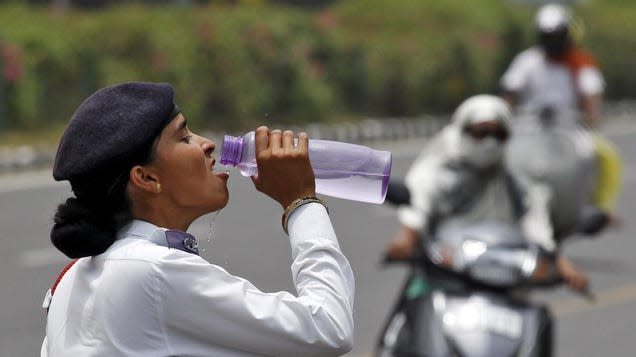Rising temperatures are pushing India towards the deadly "wet bulb" threshold

India is moving towards fatal climatic conditions. This year saw the country’s hottest February in 122 years, and it is only likely to get worse.
The central and western regions of the hot tropical country are expected to experience heat waves in March-May, according to the India Meteorological Department (IMD). Summer temperatures in northern India regularly soar beyond 40°C in May and June, the hottest months of the year. Topping 50°C is unusual, but that is happening, too.
Read more
This summer may push India closer to the limits of human survival. Rising temperatures are forecast in the coming weeks after India experienced its hottest February on record. The region is at serious risk of wet-bulb if global temperatures continue to rise. pic.twitter.com/UlJ6694Vav
— Peter Dynes (@PGDynes) March 27, 2023
Climate scientists are now worried about an increased possibility of deaths if human body temperatures exceed the “wet bulb” threshold of 35°C. A Lancet study found a 55% spike in fatalities in India between 2000-2004 and 2017-2021 due to extreme heat. This is besides the loss of labour hours and the resultant loss of income.
What is wet-bulb temperature?
When a piece of wet cloth touches the bulb of a thermometer, its reading falls. This is because the water in the cloth absorbs heat and evaporates. But if the surrounding air is saturated with water, evaporation will be minimal. This reduces the chances of the thermometer’s bulb cooling down.
The same principle is applied to the human body and perspiration. If the air around a person is too humid to absorb evaporating sweat, the chances of the person’s body temperature falling are much lower.
It is estimated that beyond 35°C, a human body can no longer cool itself through perspiration. “India is typically more humid than equivalently hot places, like the Sahara. This means sweating is less efficient, or not efficient at all,” Kieran Hunt, a climate scientist at the University of Reading told Bloomberg.
In 2022, a report by the Intergovernmental Panel on Climate Change (IPCC) stated that climate change is likely to increase temperatures in the Ganga and Indus river basins beyond the critical wet-bulb threshold if greenhouse gas emissions are not reduced.
Is India adequately prepared for a possibly fatal summer?
India’s heat action plans (HAPs), designed to tackle economically damaging and life-threatening heat waves, generally focus on dry extreme heat. It does not consider the threats posed by humid heat, according to a report by The Centre for Policy Research (CPR) released on Monday (March 27).
It is unclear if authorities consider risk factors like the duration of continuous heat, hot nights and so on, on a region-wise basis.
India has 37 HAPs across 18 states at the city, district, and state levels. Only two of these, however, have explicitly targeted vulnerable groups. The rest only have broad categories such as the elderly, outdoor workers, and pregnant women. Even the solutions proposed do not necessarily focus on them, the CPR report stated.
Moreover, these HAPs do not have enough funds. Insufficient capacity building and a lack of transparency are also matters of concern.
“There is no national repository of HAPs and very few HAPs are listed online. Further, it is unclear whether these HAPs are being updated periodically and whether this is based on evaluation data,” the report stated, emphasizing investment in areas like local heat research ecosystem.
More from Quartz
The split of the African plate could gift six landlocked countries a coastline
How Credit Suisse’s demise strengthens Switzerland’s place in global finance
Sign up for Quartz's Newsletter. For the latest news, Facebook, Twitter and Instagram.

